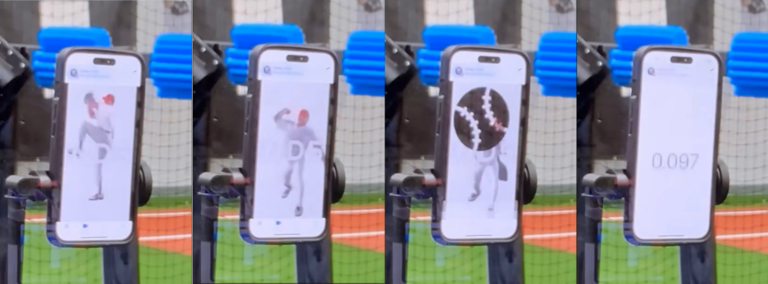
The Shadows Cast by the Launch Quickness (LQ) App’s Methodology on the HLP Swing Philosophy, Part I
By Ken Cherryhomes
Perception Over Substance
Social media has the power to replace years of hard work building a reputation and voice by handing a virtual bullhorn to anyone, elevating their novice perspectives to widely accepted expertise. This phenomenon is evident in baseball and softball, where self-proclaimed hitting gurus position themselves as singular revolutionaries and the ultimate authority on elite performance.
The rise of one particular hitting philosophy, rooted in a claim to align with the swing patterns of baseball legends like Ted Williams and Barry Bonds, exemplifies this phenomenon. Its creator, originally an unknown figure who, ironically, began his online persona on the web forum Top Velocity as a volatile and outspoken pitching expert, later transitioned to hitting. He gained traction through carefully crafted narratives and an endless stream of video analysis. By replicating swings with a mix of conviction and accidental theatrics, he divined himself the sole interpreter of elite mechanics and its ultimate philosopher. The philosophy’s claim? That it alone represents the only ‘correct’ swing pattern used by greats past and present.
The philosophy’s origins trace back to an unconventional source: a determined father who, without formal training, spent years in his basement meticulously analyzing video footage of legendary players. Through these flat, two-dimensional captures, he attempted to interpret and replicate the movements he believed defined elite swings. Eventually, he unveiled his philosophy to a social media audience, presenting it as the definitive method used by the greatest hitters.
Leveraging selectively framed video clips, he highlighted specific movements and swing elements that supported his interpretations while dismissing contradictory evidence. Using strong, often condescending language, he insisted that anyone who didn’t understand or agree with his interpretations was ignorant or incapable of grasping elite hitting mechanics. This combative approach, combined with his unrelenting social media presence, helped him cultivate a devoted following despite the polarizing nature of his claims.
Adding credibility to the narrative is a correlation he draws between the adoption of his techniques and the success of MLB players such as Aaron Judge. While this alignment creates a powerful story for supporters, it also reflects a classic post hoc fallacy: correlation without causation. The player’s success, like Judge’s, is more likely attributable to innate skill, training offset or augmented by self-organization, and a combination of factors far removed from the hitting philosophy. Yet, for a social media audience captivated by simple explanations, this one-to-one association bolsters the practitioner’s status as an ‘expert.’
Far from simplifying the mechanics of hitting, the philosophy creates its own language and an array of acronyms to describe its concepts, effectively alienating those unfamiliar with its terminology. The creator often dismisses critics and alternative perspectives by asserting that ignorance of his specialized language invalidates their opinions on hitting entirely. While this approach may solidify loyalty among followers who adopt the jargon, it does little to foster meaningful discussion or consensus within the broader baseball community.
However, while swing philosophies remain subjective, the measurable metrics of human performance—such as reaction times and swing speeds—are governed by objective standards. This distinction creates a critical vulnerability: subjective narratives may spark debate, but flawed methodologies and impossible metrics, like those reported by his LQ app, are indefensible under scientific scrutiny.
The chink in the armor emerges with the release of his app, designed to quantify one of his philosophy’s core concepts: Launch Quickness (LQ). The app, sold widely at $12.99, promises to measure a batter’s swing quickness with precision. However, its reported values—such as capture times well below 0.1 seconds—are not only improbable but biologically impossible, defying well-established standards of human reaction and response times.
Here lies the critical revelation. Either the app’s creator is unaware of the physiological impossibilities underlying his capture values, which would suggest a fundamental lack of understanding in biomechanics and human performance—or he is knowingly promoting and profiting from a flawed product, prioritizing narrative over truth. In either case, the app’s shortcomings cast a shadow on his swing philosophy and the soundness—or lack thereof—of his approach.
Unlike swing mechanics, which can be debated and viewed through subjective lenses, metrics like reaction time are rooted in hard science, leaving little room for misinterpretation.
The app doesn’t merely falter in execution; it reveals objective cracks in the foundation of the broader narrative. A hitting philosophy may thrive in echo chambers of social media, but a flawed tool that reports impossible values strips away the mystique and forces a confrontation with reality. Whether ignorance or indifference drives the app’s flaws, the result is the same: it exposes the philosophy’s underlying vulnerabilities and undermines the credibility of its creator.
I have no intention of debating swing philosophy, as such discussions are inherently subjective and often mired in personal bias. However, the objective shortcomings of the app’s reported capture values, coupled with its creator’s ignorance—or indifference—in selling and promoting it, warrant closer scrutiny of everything he is associated with. Given that his swing theory is already polarizing and controversial, often challenging established biomechanical conventions, these flaws in the app raise an important question: if his understanding of measurable human performance is so fundamentally flawed, might the foundation of his swing theory also merit deeper examination?
